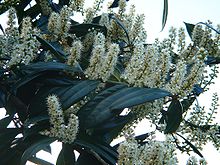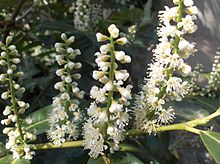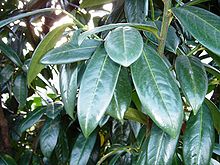- Prunus laurocerasus
-
Prunus laurocerasus 
Foliage and flowers Scientific classification Kingdom: Plantae (unranked): Angiosperms (unranked): Eudicots (unranked): Rosids Order: Rosales Family: Rosaceae Genus: Prunus Subgenus: Cerasus -[citation needed], or Laurocerasus[1] Section: Laurocerasus Species: P. laurocerasus Binomial name Prunus laurocerasus
L.Prunus laurocerasus, with common names Cherry laurel and sometimes called English laurel in North America, is a species in the genus Prunus, native to regions bordering the Black Sea in southwestern Asia and southeastern Europe, from Albania and Bulgaria east through Turkey to the Caucasus Mountains and northern Iran.[2][3]
The common name "cherry laurel" refers to the similarity of foliage and appearance to the true laurel, Bay laurel (Laurus nobilis) (family Lauraceae). However, the two plants are in different families and are unrelated.
Contents
Description
Prunus laurocerasus is an evergreen shrub or small tree, growing to 5–15 metres (16–49 ft) tall, rarely to 18 metres (59 ft) tall, with a trunk up to 60-cm broad. The leaves are dark green, leathery, shiny, (5–)10–25(–30)-cm wide and 4–10-cm broad, with a finely serrated margin. The leaves can have the smell of almonds when crushed.
The flower buds appear in early spring and open in early summer in erect 7–15-cm racemes of 30–40 flowers, each flower 1-cm broad, with five creamy-white petals and numerous yellowish stamens.
The fruit is a small cherry 1–2-cm broad, turning black when ripe in early autumn.[4][5] Unlike the rest of the plant, which is poisonous, the cherries are edible, although rather bland and with a somewhat dry smack compared to the fruit of apricots, true cherries, plums, and peaches, to which it is related. The seeds contained within the berries are poisonous like the rest of the plant, containing cyanogenic glycosides and amygdalin.[6] This chemical composition is what gives the smell of almonds when the leaves are crushed.
Cultivation
Prunus laurocerasus is a widely cultivated ornamental plant, used for planting in gardens and parks in temperate regions worldwide. It is often used for hedges, a screening plant, and as a massed landscape plant. Most cultivars are tough shrubs that can cope with difficult growing conditions, including shaded and dry conditions, and which respond well to pruning.
Cultivars
Over 40 cultivars have been selected, including[7]
- Aureovariegata, variegated, leaves with a yellow margin.
- Magnifolia, vigorous, with great leaves up to 30-cm wide and 11-cm broad.
- Otto Luyken (named after Otto Luyken), half-dwarf, with small leaves 10-cm wide and 2–3-cm broad.
- Zabeliana, selected for winter cold tolerance.
Invasive species
It has become naturalised widely in some areas, and can become an invasive species in some habitats.
In some regions (such as the United Kingdom and the Pacific Northwest of North America), this species can be an invasive plant.[8] Its rapid growth, coupled with its evergreen habit and its tolerance of drought and shade, often allow it to out-compete and kill off native plant species. It is spread by birds, through the seeds in their droppings.
- Other uses
Laurel water, a distillation made from the plant, has a pharmacological usage. The foliage is also used for cut greenery in floristry.
References
- ^ Rehder, A. 1940, reprinted 1977. Manual of cultivated trees and shrubs hardy in North America exclusive of the subtropical and warmer temperate regions. Macmillan publishing Co., Inc, New York.
- ^ Euro+Med Plantbase Project: Prunus laurocerasus
- ^ Germplasm Resources Information Network: Prunus laurocerasus
- ^ Rushforth, K. (1999). Trees of Britain and Europe. Collins ISBN 0-00-220013-9.
- ^ Flora of NW Europe: Prunus laurocerasus
- ^ Poisonous Plants: Prunus Laurocerasus
- ^ Huxley, A., ed. (1992). New RHS Dictionary of Gardening. Macmillan ISBN 0-333-47494-5.
- ^ Evergreen.ca Invasive Plant Profile
External links
Categories:- Prunus
- Flora of Europe
- Flora of Western Asia
- Flora of Albania
- Flora of Bulgaria
- Flora of Turkey
- Flora of Georgia (country)
- Flora of Armenia
- Flora of Iran
- Invasive plant species in Europe
- Invasive plant species in the United States
- Poisonous plants
- Garden plants of Asia
- Garden plants of Europe
Wikimedia Foundation. 2010.


